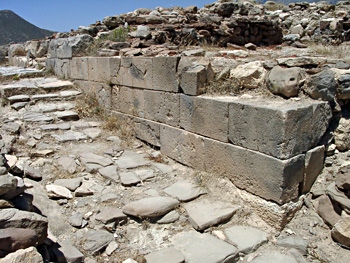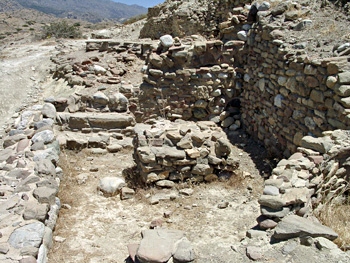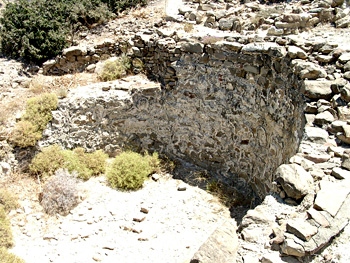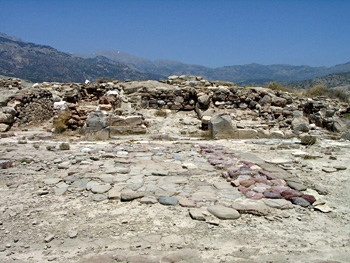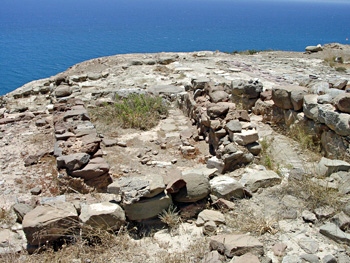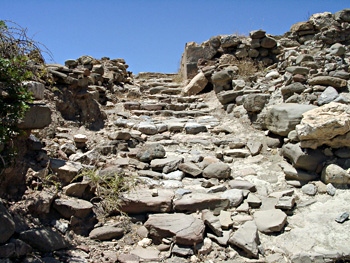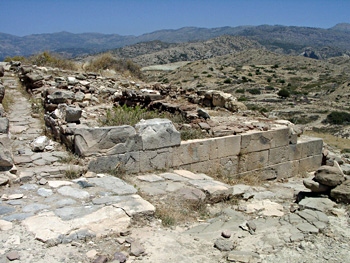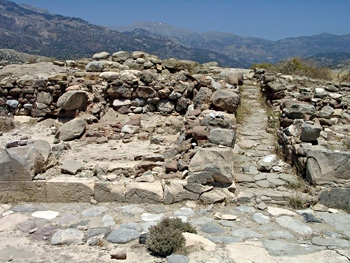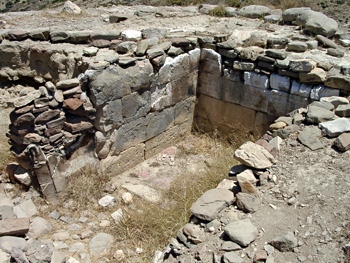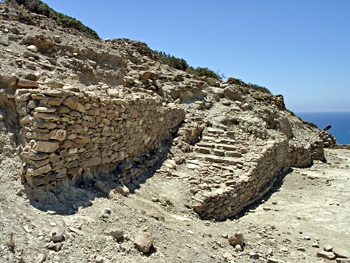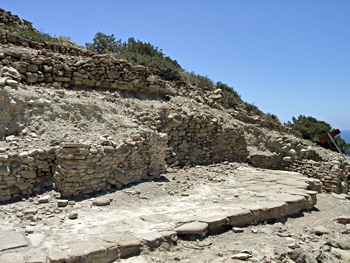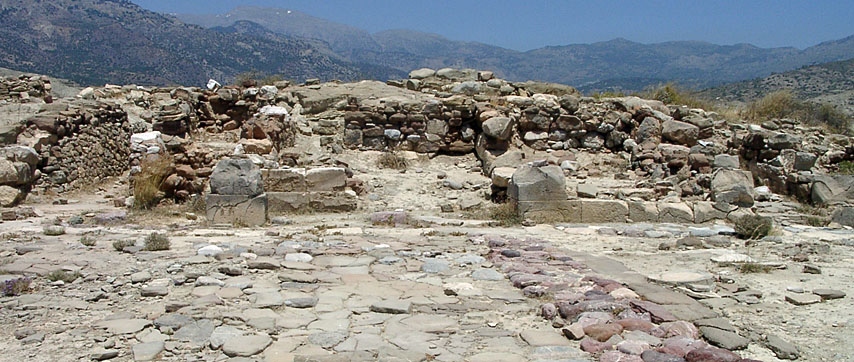
The Myrtos valley
This site was excavated by Gerald Cadogan between 1970 and 1982. The site is situated 1.7 kilometres to the west of Fournou Korifi, beside the east side of the mouth of the river Myrtos on the south coast of Crete. The valley which it overlooks would have supplied the village and its villa (or country house as Cadogan prefers to call it), with crops such as barley, vetch and olive oil. It was situated at the point on the coast where the route down from the mountains ended up and overlooked the main land route of ancient times from the north centre of the island towards the east which then ran south of the mountains which contain the Lasithi Plain. The Myrtos valley is where this route reaches the sea.
A long history
Cadogan divides its long history (from EM II to LM I) into four periods, Pyrgos I-IV. The settlement here was begun at the same time as neighbouring Fournou Korifi (EM IIA) and was, like Fournou Korifi, destroyed by fire in EM IIB.
Unlike Fournou Korifi, however, Pyrgos was resettled, though Cadogan believes that there may have been a period of desertion first. He dates the resettlement to Pyrgos II whose beginning corresponds to MM IA. The two-storey house tomb (pictured left) dates from this period and was used until Late Minoan I. There were two ossuaries (areas where the bones of the dead are collected after the bodies have fully decomposed) of which the circular one can be seen in the photo. The remains of 65 dead were found in the tomb and the ossuaries, including nine males in extended burials in the tomb chamber. Cadogan dated these remains to Pyrgos III (the Old Palace period) or to Pyrgos IV (Late Minoan I).
From the Pyrgos III period date the tower and cistern on the north slope of the hill (see photo right), as well as a smaller cistern on the hilltop itself. Cadogan believes that a large building existed on the hilltop which would later form part of the Late Minoan country house whose remains are now to be found on the site. (See photo below).
The pottery of Pyrgos III is very similar to the pottery that was found in the Old Palace at Malia on the North Coast of Crete. So it is likely that there were links with Malia despite the fact that the formidable obstacle of the Dikti mountains and the Lasithi Plain lie between the two. According to Cadogan, Pyrgos III also ended with a destructive fire.
The Country House
The country house was built on the top of the hill during Pyrgos IV (Late Minoan I). This period saw the building of many villas across the island and must have represented serious growth in Crete. It has been suggested that this development represented a delegating of control over agricultural activity to local areas. In Cadogan's view, the palatial quality of the architecture suggests that the building must have been the ruling building of the Myrtos valley. It was sourrounded by a village that may have covered half a hectare in size. Remains of some of the houses can still be seen on the site.
Of the rooms along the south facade, rooms 4-6 were basements for the rooms above, while rooms 8 and 9 were storerooms. Two north-south passageways gave access to the building, one to the west (1) and one between rooms 6 and 8 (area 7). Room 3 is thought to have been a light well. Because the house is effectively terraced as the rock rises to the north, the staircase (2) would have led to the ground floor at that point. If there was another storey above this then the building would have had three storeys in all, starting with the basement rooms at the front of the building. There is evidence for a shrine on the upper floor as some of the contents of this room have been identified. In fact there may have been more than one shrine in the building, as objects that had fallen into the street from rooms above the storerooms also had cult associations. An annexe stood on the east side of the courtyard.
Among the finds were Linear A tablets, clay sealings, clay tubular stands, two clay nodules, a jug in the Marine style and other small items. Cadogan points out that here we have evidence of religion, administration and economic activity combined on one site. He feels sure that the movable finds taken from the site have all the hallmarks of a shrine. He writes "The shrine is in the grand house of the district, the social, economic and administrative centre, which dominates the country around and lived off its produce. The building is of metropolitan elegance and its inhabitants put objects of metropolitan workmanship in their shrine and elsewhere in the house. All the evidence of the country houses suggest that their links with the palaces, and especially Knossos, were close; and the presence of bureaucratic documents in the shrine support this...the blending of god and mammon, and the divine direction of most or all parts of daily life (which) are such important features of Minoan civilisation. They were attitudes that permeated the culture of New Palace period society, or at least that of the grandees."
The country house was burnt down in Late Minoan IB, though the surrounding houses in the village were not apparently burnt. To Cadogan this suggests that the fire was deliberately started, rather than the result of an accident or earthquake. The targetting of important buildings at this time has also been noted in other parts of Crete.
In more recent times a watch-tower was built on the top of the hill and the foundations can still be seen. It is from the Greek word for tower -- Pyrgos -- that the hill and the site take their name. The site is unfenced, a little difficult to find and a steep climb but well worth it both for the archaeological site itself and the spectacular views of mountain scenery, the Myrtos valley and the sea.

